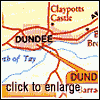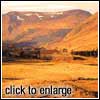|
Perth
Perth is the communications centre for this part of Tayside
and long referred to as the 'Gateway to the Highlands' although the hills are still
a fair drive on. The 'Fair City' as it is also dubbed, with its tall spires and shallow
River Tay flowing through it, is surrounded by two wide parklands. The North Inch,
the site of the famous Battle of the Clans in 1396, is played over by a municipal
golf course next to the Bells Sports Centre while the South Inch holds various facilities
for bowling, boating and field games.
There is strong evidence of Roman occupation of the
Perth area although the town does not appear in records until the twelfth century.
Later it was to become Scotland's capital, much favoured by James I. The walled,
royal burgh with its navigable river provided an excellent inland port making Perth
prosperous throughout the sixteenth century.
Perth Art Gallery and Museum presents exhibitions
that illustrate the development of local industry particularly whisky, which remains
very important to the area along with the insurance industry. Silverware is also
on display fashioned by the county's craftsmen of three centuries and there are good
depictions of Perth's local history.
The Fair Maid's House situated behind Charlotte Street
in North Port was the home of Sir Walter Scott's heroine, Catherine Glover and is
one of the oldest houses in Perth. It contains a well-stocked and popular craft and
gift shop.
 The nearby Church of St John is quite small and unadorned
and was the scene of John Knox's most inflammatory sermons in 1559. The nearby Church of St John is quite small and unadorned
and was the scene of John Knox's most inflammatory sermons in 1559.
The famous Aberdeen Angus Bull Shows are held early
in February and October at the Agricultural Centre on the Creiff Road near the outskirts
of town. The Perthshire Agricultural Show is held in August and horse racing takes
place regularly at Scone Race Course.
The city of Perth also offers a fine Victorian theatre
with an excellent restaurant and bar inside. Shopping is of high quality and variety
and there is a good level of accommodation. B&B's are concentrated on the north
side of town.
 To the north east of Perth is Kinnoul Hill, one of Perthshire's
best vantage points, reached by either a short drive and half mile woodland walk
from the car park (quite steep in parts or a steady 40 minute walk from the town.
The extraordinary view from this precarious vantage point overlooks the east end
of Perth, the River Tay and the Carse of Gowrie with distant views north to the Grampians.
Branklyn Gardens, (open to the public) at the foot of Kinnoul Hill has been described
as the finest two acres of private garden in the country. To the north east of Perth is Kinnoul Hill, one of Perthshire's
best vantage points, reached by either a short drive and half mile woodland walk
from the car park (quite steep in parts or a steady 40 minute walk from the town.
The extraordinary view from this precarious vantage point overlooks the east end
of Perth, the River Tay and the Carse of Gowrie with distant views north to the Grampians.
Branklyn Gardens, (open to the public) at the foot of Kinnoul Hill has been described
as the finest two acres of private garden in the country.
Perth Leisure Pool, just off the Glasgow Road, is
Scotland's most advanced water-works complete with flumes, wild-water rides, and
outdoor lagoon and bubble beds. There is also a good diner & bistro.
Further west is Bell's Cherrybank Gardens just off
the A9 on the Glasgow Road and part of the whisky distiller, Arthur Bell's head office.
It incorporates the Bell's National Heather Collection along with a bright, pleasant
cafe.
The village of Abernethy is found by passing through
Bridge of Earn and following the A913. It overlooks the upper reaches of the Tay
and a charming, unspoilt conservation village, an ancient Pictish capital in an area
of manifold Pictish artefacts.
At the southern entrance to Tayside, Kinross is a
main town surrounded by several interesting areas. In the town itself is a seventeenth
century Tolbooth and in the High Street a museum devoted to local history, linen
and peat. In summer, the gardens at Kinross House offer the experience of a magnificent
seventeenth century formal design with yew hedges, herbaceous borders and rose beds
to accompany the wonderful views across Loch Leven. The island and its fortress set
in the middle of this famous trout fishing loch was the prison of Mary Queen of Scots.
It can be visited by taking the small ferry from Kirkgate Park in Kinross. In 1567
Mary Queen of Scots was exiled to Loch Leven Castle.
Five miles (8km) south of Kinross is a converted farm
with displays that interpret the local environment and its animal inhabitants. The
area surrounding Vane Farm is a favourite resting-place for wild geese and ducks
and there are facilities provided to observe these and other animals more closely
throughout the year. The Butterfly Farm at Turfhills in Kinross is a tropical habitat
for butterflies and moths from around the world. There is also a children's farm,
an aviary, cafe and gift shop.
Going back into Perth and travelling west on the A85
you arrive at Huntingtower Castle, a castled mansion, originally the hunting seat
of the Earl of Ruthven. The painted timber ceiling on the first floor of the eastern
tower is one of the earliest of its kind done around 1540. Another feature is the
dovecote in the garret of the western tower. Huntingtower Castle Hotel, signposted
just beyond the castle entrance, is well-worth stopping for lunch and they offer
an excellent standard of accommodation.
Travelling west again along the A85 Fowlis Wester,
5 miles (8km) before Crieff, is a charming little conservation village. The thirteenth
century Church of St Bean houses a richly carved, eighth-century Pictish stone while
the village square holds a 10ft (3m) high Pictish cross slab bearing a cross on one
side and an equestrian scene on the other.
 Crieff is situated on the southern slope of an impressive
wooded hill, the Knock, on the physical and cultural boundary between the Scottish
Highlands and the Lowlands. Crieff's history includes the town being the administrative
capital of twelfth-century Celtic Earls. It later grew to become one of the most
famous market towns of Scotland where Highlanders drove their cattle from as far
as Caithness and the Outer Hebrides to feed the growing population of the Lowlands.
Many were hanged at Gallowhaugh - now Gallowhill. The Weaver's House and Highland
Tryst Museum in Crieff shows the development and skills of the Master Weavers of
Strathearn and the traditional tartans for which they became famous. Crieff is situated on the southern slope of an impressive
wooded hill, the Knock, on the physical and cultural boundary between the Scottish
Highlands and the Lowlands. Crieff's history includes the town being the administrative
capital of twelfth-century Celtic Earls. It later grew to become one of the most
famous market towns of Scotland where Highlanders drove their cattle from as far
as Caithness and the Outer Hebrides to feed the growing population of the Lowlands.
Many were hanged at Gallowhaugh - now Gallowhill. The Weaver's House and Highland
Tryst Museum in Crieff shows the development and skills of the Master Weavers of
Strathearn and the traditional tartans for which they became famous.
The Perthshire Highland Golf Ticket can be purchased
at the Crieff Tourist Information Office allowing play on the five participating
9-hole courses throughout a 5 day period and is exceptional value. Crieff Visitor
Centre is a commercial development just south of the town. Here you will find traditional
crafts allied to modern technology to produce the internationally known Stuart Crystal.
The fascinating process of blowing the molten glass can be watched from the viewing
gallery. Across the road is the Crieff Plant Centre, Buchan Pottery and Perthshire
Paperweights with a myriad of potential gifts. There is also a modern self-service
restaurant, which serves a variety of good dishes.
Innerpeffray Library, 4 miles (6km) south-east of
Crieff, is a must for book-worms or anyone interested in Scotland's oldest surviving
free-lending library which houses 3,000 titles printed between 1502 and 1800.
Drummond Castle, 2 miles (3km) south of Crieff, was
originally built around 1490 but destroyed intentionally in 1745 by its owner, the
Duchess of Perth, to prevent its falling into the hands of Cromwell's troops. It
was then rebuilt in Tudor style and includes a magnificent Italian formal garden.
Muthill is another conservation village 3 miles (5km) south of Crieff on the A822.
It is largely unspoilt with late eighteenth-and early nineteenth-century housing
and architecture. The church at the village's centre was once an important fifteenth-century
focus of worship with an earlier twelfth century Norman tower.
Continuing south on the A823 brings you to Auchterarder,
a long Strathearn town with a fairly rich historical past and most of its older buildings
hugging the High Street. The town became chief burgh of the important earldom of
Strathearn shortly after the turn of the eleventh century. During an early Jacobite
rising in 1715 the town was destroyed by the retreating Earl of Mar. The tower in
the old churchyard is the only remnant of the town's turbulent past. In rooms above
the tourist office, a heritage display illustrates the regions past.
The sumptuous Gleneagles Hotel, golf courses and leisure
complex sits above a scenic wooded and moorland glen surrounded by the Ochil Hills
with Glen Devon to the south. Contrary to its inference, the name, Gleneagles, is
not associated with that majestic bird of prey but is Gaelic for'glen of the church'.
Ardoch Roman Camp, 10 miles (16km) south of Crieff near Braco on the A822, dates
back to the second century. This was one of the largest Roman encampments of ancient
Britain.
To the west of Crieff about 1 mile (2km) on the A85
is Scotland's oldest Malt Scotch Whisky distillery. Established in 1755 alongside
the Shaggie Burn, the Glenturret Distillery offers guided tours around the stills.
It also has an award winning visitor's heritage centre. The distillery also offers
two good restaurants, the Smuggler's and the Pagoda Room, a gift and whisky shop
with, of course, a whisky-tasting bar.
Comrie's claim to fame might be that it sits directly
on the Highland Boundary fault and experiences regular earth tremors of no great
consequence. Earthquake House, built in 1874, situated just outside Comrie at the
Ross, contains a replica of the first seismometers set up here in the Victorian era.
There is a good healthy eatery just past the Ross Bridge on the west side of town,
Tullybannocher Farm Food Bar and Restaurant alongside several craft shops and a nursery.
At midnight on Hogmanay in Comrie, a unique Flambeaux
Procession takes place, a torchlight parade through the streets to drive out the
evil spirits for the coming year, followed by the usual Scottish exuberance for this
particular holiday period.
Just north of Comrie is the Deil's Cauldron which
is a grand waterfall carrying the River Lednock down to meet the River Earn. Two
miles (3km) south of town on the B827 is the Auchingarrich Wildlife Centre which
holds the largest bird collection in Scotland in its 100 acres (40hectares). There
are 17 ponds with 100 species of water-fowl and a wild bird hatchery where you can
watch newly hatched chicks. Wallabies, Highland cattle and deer occupy the larger
enclosures. Afterwards there is the welcoming Pine Lodge restaurant. Another good
stop in these parts, especially if you have children, is Drummond Trout Farm and
Fishery. There are several ponds to cater for every angler, no matter how inexperienced.
At the eastern end of Loch Earn still following the
A85, St Fillans is frequently regarded as one of Scotland's best kept secrets and
another choice stopping place. The village, formerly known as Port of Lochearn, was
later called St Fillans after the Celtic missionary from Ireland called Faolan. In
the sixth century he established himself on Dunfillan or St Fillan's hill and set
about converting the local Picts to Christianity. Here too, are water-sports and
sailing although most of the activity is based around Loch Earn Caravan Park on the
south side of this end of the loch. A more sedate site is the St Fillan's Caravan
Site at the old railway station. For an easy amble, try the relatively flat St Fillans
Golf Course.
Follow the shoreline to Lochearnhead then north to
Killin on the A85. It is then possible to return to Perth along the shores of Loch
Tay on the A827. Ben Lawers is Tayside's highest mountain at 3,984ft (1,215m) and
famous for its alpine plants growing on southerly facing slopes. To find them may
not be easy but a visit to the Ben Lawers Visitor's Centre run by the National Trust
for Scotland will help you to understand this rare and special environment. Ben Lawers
has been a National Nature Reserve since 1975.
 Glen Lyon can be entered continuing past the Ben Lawers Visitor
Centre on the minor road heading north, an interesting drive over some high moorland.
It is the longest of the Scottish Glens and was Campbell country before the Clearances
but now, as with so many 'improved' glens, it caters mainly to sheep. Set back a
few miles from Loch Tay at its eastern end is the village of Fortingall. The row
of cottages are particularly enchanting, most of them still thatched. Near the church
at the east end of the village is the Fortingall Yew. This undistinguished piece
of vegetation, now split and sagging like a badly tended and overgrown bush, is perhaps
the oldest living thing in Europe. At around 3,000 years old it was in existence
during the era of the Roman Empire and the birth of Christ. Glen Lyon can be entered continuing past the Ben Lawers Visitor
Centre on the minor road heading north, an interesting drive over some high moorland.
It is the longest of the Scottish Glens and was Campbell country before the Clearances
but now, as with so many 'improved' glens, it caters mainly to sheep. Set back a
few miles from Loch Tay at its eastern end is the village of Fortingall. The row
of cottages are particularly enchanting, most of them still thatched. Near the church
at the east end of the village is the Fortingall Yew. This undistinguished piece
of vegetation, now split and sagging like a badly tended and overgrown bush, is perhaps
the oldest living thing in Europe. At around 3,000 years old it was in existence
during the era of the Roman Empire and the birth of Christ.
Another surprising aspect of Fortingall is the myth
that Pontious Pilot was born here. It is said that his father was a Roman envoy sent
by Caesar Augustus to help quell the warlike activities of the Picts and he had a
child with a local woman, perhaps one of the Menzies Clan. The father returned to
Rome with his son. Later in life, Pontious returned to retire and die here in Fortingall.
The legend has been further substantiated by the discovery earlier this century,
of a large stone slab near the village bearing the initials P.P.
Kenmore is one of Perthshire's activity centres. Situated
on the east end of Loch Tay there is a host of water-sport activities such as water-skiing,
jet skiing, sailing, and further down the river, white-water rafting. It is also
one of Scotland's premier salmon fishing sites.
There is a good camping site on the banks of the river
for touring caravans and tents or for renting holiday caravans. The farm steading
also offers accommodation in cottages or, for hikers, in a communal bothy. There
is an excellent bistro on site along with a boules pit, a 9 hole golf course and,
in the bistro in the evening, regular musical entertainment.
On the opposite side of the loch is Croft-na-Caber
Activity Centre which offers jet skis and dinghies. Next to it, you can visit a fascinating,
educational development, The Scottish Crannog Centre, where a replica Crannog or
Bronze Age defensive loch-dwelling has been built. These habitats, this replica being
50ft (15m) in diameter and thatched with examples of tools and domestic utensils
inside, were popular in this area from the Bronze Age until around 300 years ago.
There were 18 Crannogs in Loch Tay alone. The onshore interpretative centre shows
artefacts, timbers and other underwater discoveries as well as video and slide presentations.
From Kenmore you can take the steep back road climbing
across Glen Quaich to Amulree (10 miles/16km). Once you have negotiated the steepest
part of the road, stop and look back over the valley of Loch Tay and Kenmore. The
prospect is exceptional and this is a fine spot for a pastoral picnic with views.
The narrow road then twists over moorland and past lochan. Isolated as it is, this
area was once a favourite hunting ground for Scottish Kings. Amulree was an important
junction of the old drove roads where the cattle drovers broke their long journeys.
There is a hotel in Amulree, established in 1714, where Bonnie Prince Charlie rested.
Following the old drove road, the A822 descends from
Amulree towards Crieff. It passes through the 'Sma Glen', a colourful valley surrounding
the River Almond. In the late summer the hills, rising steeply on either side of
the glen, come alive with blossoming purple heather. You can also see salmon leaping
at various points on the river at this time of the year. The best place is the Buchanty
Spout in Glen Almond on the B8063.
Scone
 Scone Palace just north of Perth is a site of great historical
significance. Here, at Moot Hill, just in front of the present-day palace, Scotland's
Kings from Robert the Bruce to James VI came to be crowned. Scone Palace just north of Perth is a site of great historical
significance. Here, at Moot Hill, just in front of the present-day palace, Scotland's
Kings from Robert the Bruce to James VI came to be crowned.
The tiny chapel you see today is perched on a small
mound known as Moot Hill. The earls and chieftains allied to the king were charged
to bring soil from their land in their boots and swear fealty to the Lord High Ardh
while standing on their own 'land'. Having taken the oath, they emptied out the contents
and formed Moot or Boot Hill.
The ancient Abbey of Scone, which stood nearby the
present palace, was another victim of the followers of John Knox and nothing remains
of this site.
Scone is also known to have been the centre of the
Scoto - Pictish Kingdom. Kenneth MacAlpin, King of Scots, established the ceremonial
enthronement of the Scottish Kings on the Stone of Destiny here. The famous stone
was brought to Scone in the ninth century for this purpose and such was the Stone's
importance that it was removed to Westminster Abbey in London by Edward I following
his victory over the Scots in 1296.
It was been part of the Coronation Chair until it
was back to Scotland recently although it was temporarily removed by Scots Nationalists
in the 1950's and supposedly recovered but rumours have circulated that it was hidden
in a church in Dundee and a false stone put in its place. (See further information
in Stone of Destiny box)
Scone Palace, originally a sixteenth century castellated
mansion, enlarged and embellished in 1803, is richly furnished in neo-Gothic style
with some superb pieces of French furniture, ivory and porcelain. It is still a family
home and is open from Easter until October for the public. There are good facilities
in and surrounding the house making it worth a prolonged stop.
The Stone of Scone (pronounced "skoon'') or,
alternatively, the Stone of Destiny, was returned to Scotland after 700 years, in
July, 1997. The rough-hewn, 400lb lump of yellow sandstone was the coronation seat
of Scottish kings until it was carried away as war booty by King Edward I in 1296.
Since then it had been placed under the coronation chair in Westminster Abbey, where
it has been involved in all coronations of all English and British sovereigns.
Due to its intimate association with the Sacrament
of Coronation, there was much consternation in Westminster at the return of the stone.
The Coronation Chair, made in 1301, was designed to contain it and looks rather scant
in the stone's absence.
The government said little about why it decided to
return the stone, though Prime Minister at the time, John Major, mentioned in his
announcement that this was the 700th anniversary of the stone's removal. Many Scots
surmise this minor concession was intended to shore up the Conservative Party's rapidly
shrinking support in Scotland.
The stone's history is full of enigma and intrigue.
According to legend, the Melesians (ancestors of the Irish), believed that the stone,
originally emanating from the Holy Lands, could identify a rightful ruler of the
country. It became the property of the early kings of Ireland and in the 6th century,
it was taken to Scotland.
With the unification of the Picts and Scots tribes
in the 9th century by King Kenneth MacAlpine, the stone was removed to Perth for
his crowning and remained there on Moot Hill until Edward took it to Westminster.
Surrounding this historic account are several unresolved
controversies. Some say the true stone never left Ireland while others claim the
stone that Edward carted off was a hastily made fake and that the real Stone has
been in Scotland all this time, its location known only by a select band.
 And yet others claim that when the stone at Westminster Abbey
was stolen in the 1950's, the group responsible replaced it with a fake, which they
gave to the English government. Whatever the truth may be, a stone, said to be the
true Stone of Scone, now rests on public view in Edinburgh Castle. And yet others claim that when the stone at Westminster Abbey
was stolen in the 1950's, the group responsible replaced it with a fake, which they
gave to the English government. Whatever the truth may be, a stone, said to be the
true Stone of Scone, now rests on public view in Edinburgh Castle.
|






